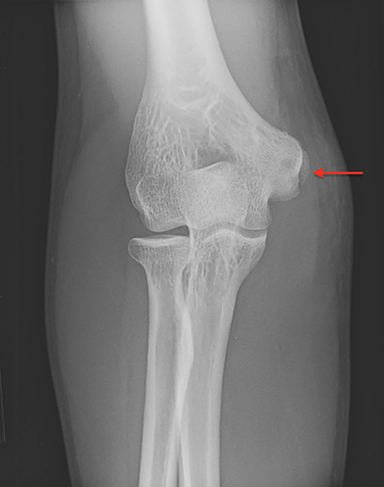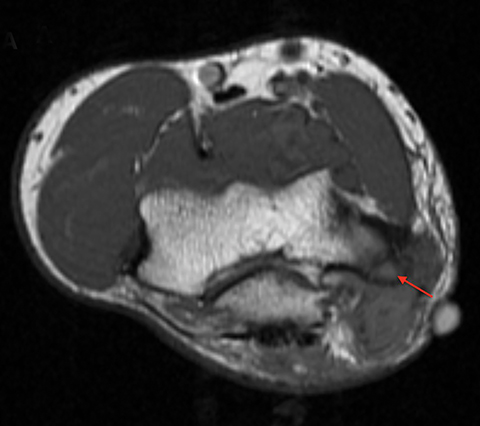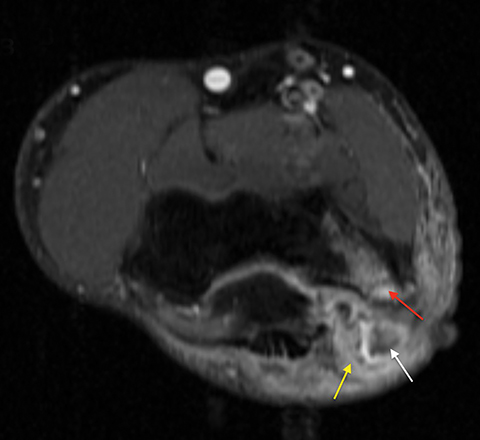Coccidioidomycosis with musculoskeletal involvement
Images




CASE SUMMARY
A 30-year-old man from Southern California with no significant medical history presented to the emergency room with a one-month history of progressive right elbow pain. He denied trauma, repetitive arm activity, interaction with pets, gardening, fevers, weight loss, or other joint pain. On physical exam, patient was afebrile with normal vital signs. A 4 × 4 cm mildly tender nodule with minimal erythema and warmth was palpated in the medial aspect of right elbow.
IMAGING FINDINGS
An X-ray of the right elbow showed soft-tissue edema surrounding calcification adjacent to the right medial epicondyle, likely within the common flexor tendon and concerning for epicondylitis (Figure 1). Ultrasound of the right elbow demonstrated a prominent lymph node with hyper-vascularity consistent with a reactive lymph node (Figure 2).
An MRI scan was obtained to further characterize the suspected mass. The images demonstrated abnormal hypointense signal in the medial epicondyle on T1-weighted MR imaging (Figure 3). A postcontrast T1-weighted MR image with fat saturation showed enhancement in the medial epicondyle and the adjacent soft tissue, concerning for osteomyelitis or primary bone lesion. There was also a fluid collection with peripheral enhancement within the enhancing soft tissue, suggestive of an abscess (Figure 3).
Histological diagnosis was subsequently pursued. Since a primary bone tumor was in the differential, an ultrasound-guided biopsy of the enlarged lymph node (Figure 2) was performed to avoid altering the bony lesion. It showed a granulomatous inflammation with spherules, consistent with coccidioidomycosis.
A CT scan of the thorax was performed to evaluate for asymptomatic pulmonary lesions; it showed a focal consolidation in the inferior right middle lobe and a small focus of peribronchial opacity in the peripheral-inferior lingula.
DIAGNOSIS
Coccidioidomycosis with musculoskeletal involvement. Differential diagnosis includes primary bone malignancy, septic joint, osteomyelitis, and tuberculosis/other granulomatous disease.
DISCUSSION
Coccidioidomycosis is caused by inhalation of the spores of two genetically distinct but morphologically identical species of fungus, Coccidioides immitis and Coccidioides posadasii. It has worldwide distribution but is most prevalent in southwestern United States, Mexico, and South America.1,2
Coccidioidomycosis is diagnosed by clinical symptoms, serology, culture, and/or tissue biopsy. Nonspecific flu-like symptoms develop in 40% of affected patients and the rest are asymptomatic. Coccidioidomycosis most often manifests as pulmonary illness. In 75% of cases, it is seen as solitary or multi-segmental or lobar consolidation on CT chest, and up to 15-20% develop pleural effusion.3
Approximately 1% of cases result in disseminated disease,4 with asymptomatic patients being particularly at risk. This leads further to delays in diagnosis and treatment.1,2 Most commonly affected extra-pulmonary sites include bone, joints, skin, soft tissue, and meninges.5 Musculoskeletal involvement occurs in 10-50% of patients with disseminated disease.5 The most common patterns seen on radiography are punched-out lytic lesions with circumscribed margins, permeative destruction with periosteal reaction, and soft tissue disease. On CT, the lesions are hypodense. The most sensitive, although relatively nonspecific, modality for detecting early disease is MR imaging, which shows T1-hypointense and T2-hyperintense lesions.6,7 Serology tests can be helpful in suspected cases. A coccidioides complement fixation titer that is high, particularly greater than 1:16, may indicate disease disseminated to the bone.8 Culture or tissue biopsy provides definitive diagnosis when endospore-containing spherules are observed. The initial treatment of coccidioidomycosis is oral fluconazole or itraconazole.
Our patient had asymptomatic pulmonary coccidioidomycosis (as proven on post-biopsy CT), which spread to involve his right elbow. Given his lack of pulmonary symptoms and immunocompetence, primary bone malignancy was high on the differential diagnosis for his painful bony mass. Soft tissue infection and osteomyelitis were of concern, particularly given the MRI findings; however, the normal ESR and CRP were more suggestive of other etiologies. Ultimately, tissue biopsy revealed granulomatous inflammation with spherules consistent with coccidioidomycosis. His coccidioides complement fixation titer was elevated (1:32), corroborating the diagnosis of disseminated disease. Our case illustrates how granulomatous diseases such as cocciodioidomycosis can mimic malignancy.2,9 Obtaining a good clinical history and maintaining a high suspicion for asymptomatic or disseminated coccidioidomycosis is important in patients who have resided or travelled in endemic areas.
CONCLUSION
Musculoskeletal coccidioidomycosis is extremely rare but can occur in 10-50% of patients with disseminated disease and could be mistaken for a neoplasm. Diagnosis and treatment of disseminated coccidioidomycosis are usually delayed in patients without pulmonary symptoms. It is important for clinicians to obtain good clinical history and have high suspicion for coccidioidomycosis for patients who have resided in or traveled to endemic areas.
REFERENCES
- Capoor, M.R., et al., Coccidioidomycosis masquerading as skeletal tuberculosis: an imported case and review of coccidioidomycosis in India. Trop Doct. 2014. 44(1):25-8.
- Arora, N.P., et al., Coccidioidomycosis masquerading as malignancy. BMJ Case Rep. 2012. 2012.
- Jude, C.M., et al., Pulmonary coccidioidomycosis: pictorial review of chest radiographic and CT findings. Radiographics. 2014. 34(4): p. 912-25.
- Malo, J., et al., Update on the diagnosis of pulmonary coccidioidomycosis. Ann Am Thorac Soc. 2014. 11(2): p. 243-53.
- Berli, J.U., W.N. Campbell, and R.D. Katz, Coccidioidomycosis causing osteomyelitis of the hand in an immunocompetent patient. Hand (NY). 2015. 10(3): p. 562-4.
- Zeppa, M.A., et al., Skeletal coccidioidomycosis: imaging findings in 19 patients. Skeletal Radiol. 1996. 25(4): p. 337-43.
- Olson, E.M., et al., Coccidioidal spondylitis: MR findings in 15 patients. AJR Am J Roentgenol. 1998. 171(3): p. 785-9.
- Sandoval, J.J., et al., Midfoot coccidioidal osteomyelitis. A case report and review of the literature. J Bone Joint Surg Am. 2006. 88(4): p. 861-5.
- Wilde, G.E., C. Emery, and J.F. Lally, Radiological reasoning: miliary disease, vertebral osteomyelitis, and soft-tissue abscesses. AJR Am J Roentgenol. 2008. 190(3 Suppl): p. S11-7.
Citation
YW L, M J, H L, R V. Coccidioidomycosis with musculoskeletal involvement. Appl Radiol. 2019;(6):44-45.
November 15, 2019